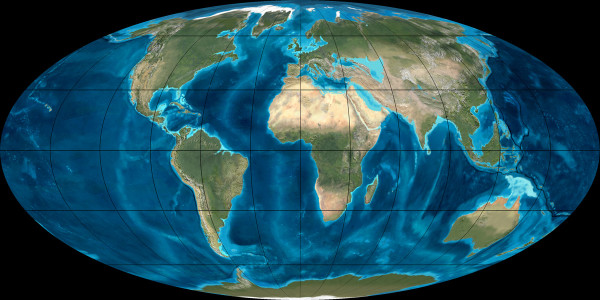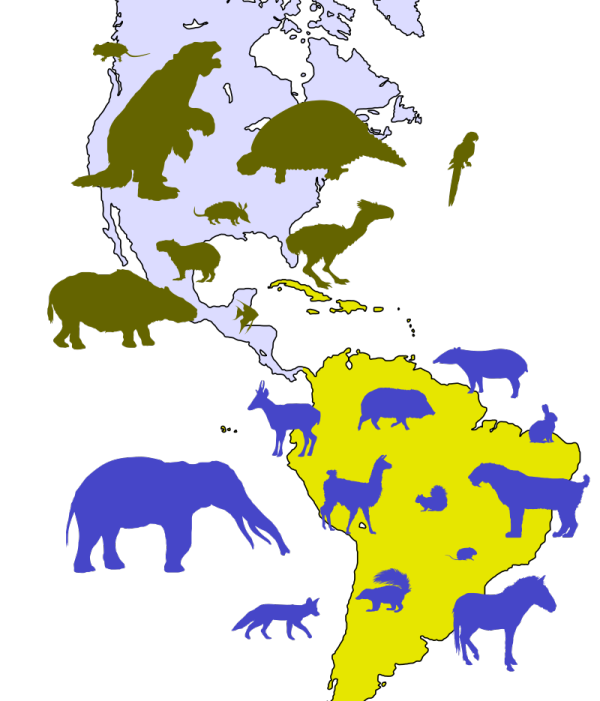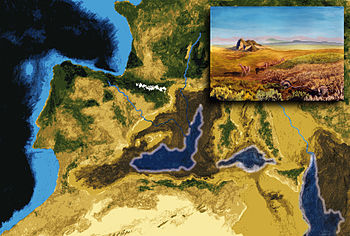History of the Horse – Part 08
|
|
Geschichte des Pferdes – Teil 08
|
Pliocene 1
- During the Miocene, which lasted about 17.7 million years, we saw great changes in the geography (all those mountain ranges!) as well as in our primeval horses – their anatomy, their teeth etc. Weather conditions were mainly sub-tropical, although there was a cooling trend toward the end.
- In the Pliocene era, which began about 5.3 million years ago and ended 2.6 million years ago, the climate still remained stable and warm. In this “short” period of a mere 2.7 million years nevertheless a great deal happened – the continental plates kept swimming around to great effect, which strongly influenced the climate and therefore also the development and migrations of the animals.
|
|
Pliozän 1
- Während des Miozäns, das ja etwa 17.7 Millionen Jahre dauerte, sahen wir große Veränderungen in der Geographie (alle diese sich auftürmenden Gebirge!) wie auch in unseren Urpferden – in ihrer Anatomie, ihren Zähnen usw. Die Wetterbedingung- en waren subtropisch, obwohl zum Ende hin eine Abkühlung eintrat.
- Im Pliozän nun, das etwa vor 5.3 Millionen Jahren begann und vor 2.6 Millionen endete, war das Klima recht stabil und noch warm. In dieser „kurzen“ Zeit von nur 2.7 Millionen Jahren passierte dennoch eine Menge – die Kontinentalplatten schwammen eifrig herum, was wiederum das Klima beeinflußte und daher auch die Entwickung und Wanderungen der Tiere.
|
 The World in the Pliocene: the isthmus of Panama is closing, the Bering Strait can be crossed on foot. the Mediterranean Sea dries out and re-floods!
Die Welt im Pliozän: die Landenge bei Panama schließt sich, die Beringstraße ist begehbar, und das Mittelmeer trocknet aus und flutet wieder!
|
- At the end of the Pliocene, about 2.6 million years ago, the land bridge between South and North America formed through the Isthmus of Panama, causing the Great American Faunal Interchange, a time when two long-isolated faunas came into contact. Sixteen native southern genera moved to the north, including armadillos, giant ground sloths, flightless predatory birds, marsupials (including opossums), and porcupines. At the same time, 23 native northern genera moved south, including cats, dogs, bears, tapirs, camels, and certain rodents. The exchange was not a balanced one, however. Many more South American immigrant species became extinct, perhaps as a result of competition and the inability to adapt to new conditions.
|
|
- Am Ende des Pliozäns vor etwa 2.6 Millionen Jahren formte sich eine Landverbindung zwischen Nord- und Südamerika beim Istmus von Panama, was eine große Völkerwanderung der Tiere in Bewegung setzte – eine Zeit, in der sich zwei bisher völlig getrennte Faunenwelten trafen. 16 südliche Arten wanderten nach Norden, darunter Armadillos, Riesenfaultiere, nicht-fliegende Raubvögel, Marsupials wie Oppossums und Stachelschweine. Gleichzeitig wanderten 23 nördliche Arten nach Süden, darunter Katzen, Hunde, Bären, Tapire, Kamele und Nagetiere. Der Austausch blieb aber nicht gleichgewichtig. Viele der südamerikanischen Immigranten starben bald wieder aus, sei es aus Konkurrenzkampf oder der Unfähigkeit sich an neue Umstände anzupassen.
|
 As South America joins the Northern part of the continent for the first time, 16 native genera from the South moved North (shown brown) and 23 moved South (shown blue).
Als sich Nord- und Südamerika zum ersten Mal zusammenschließen, wandern 16 Arten von Süden nach Norden (braun) und 23 Arten Arten von Norden nach Süden (blau). |
- Sea level changes exposed the land-bridge between Alaska and Asia and migrations therefore continued via the Bering land bridge. Mastodons and horses were among these migrating mammals, along with armored glyptodonts and many species of camels. Mammoths and a very large kind of elk and moose moved into the European region, as well as the precursors of our present wolves. Crocodiles, giant tortoises and tapirs vanished from Europe. North American rhinos became extinct.
- At the same time and because of Africa’s collision with Europe the precursor of the Strait of Gibralta closed tight during the Pliocene 5.6 million years ago.
|
|
- Ein Absinken des Meerespiegels legte die Landbrücke zwischen Alaska und Asien trocken und Tiere wanderten weiterhin über die Beringstraße ein. Mastodons und Pferde waren unter ihnen, auch Glyptodons und verschiedene Kamelarten. Mammuts und Riesenelche und -hirsche und die Vorläufer unserer heutigen Wölfe wanderten auch nach Europa, während Krokodile, Riesenschildkröten und Tapire aus diesen Gegenden nun verschwanden. In Nordamerika starben die Nashörner aus.
- Zur selben Zeit, vor etwa 5.6 Millionen Jahren, verschloß sich wegen des Zusammenstoßes von Afrika mit Europa die Straße von Gibraltar völlig.
|
 5.6 million years ago Africa collided with Europe in such a way that the Mediterranean Sea was closed off and dried out.
Vor 5.6 Millionen Jahren stieß Afrika so mit Europa zusammen, daß sich die Landenge von Gibralta schloß und das Mittelmeer austrocknete.
|
- Because of the generally dry climate conditions, within a millennium the Mediterranean basin nearly completely dried out, evaporating into a deep dry basin bottoming at some places 3 to 5 km (1.9 to 3.1 mi) below the world ocean level, with a few hypersaline Dead Sea–like pockets.
- This is maybe not so very important when considering the development of our horses, but I find it so astonishing that I will mention it anyway: it gives me the feeling of living on slippery slopes – and makes me conscious of the fact of how everything still moves…
- As shown in sea floor core samples, during the crisis the basin evaporated and was re-flooded a stunning 69 times, as rising mountains temporarily closed off the sea, but periods of either (or both) rising sea levels or tectonic subsidence caused a refilling of the basin. The crisis lasted for approximately 300 000 years before the opening closed again a final time 5.6 million years ago, and the Mediterranean Sea evaporated within a millennium.
And it will happen again!
- At some point a few million years in the future, the continued northeastward movement of Africa will close the Strait of Sicily and the Strait of Gibraltar, and the Mediterranean Sea will dry up once again. Eventually, the entire basin will close as the African Plate continues to collide with Eurasia and the Mediterranean sea floor will either be pushed up into new mountains or subducted under Europe. So get rid of your Mediterranean real estate in time!
|
|
- Da die Klimazustände ziemlich trocken waren trocknete das Mittelmeerbecken innerhalb eines Jahrtausend fast völlig aus und wurde ein etwa 3 bis 5 km unterhalb des Meerespiegels gelegenes tiefes Becken, das nur einige total versalzene, dem toten Meer ähnliche Wasserlöcher hatte.
- Das mag im Bezug auf die Entwicklung unserer Pferde nicht so wichtig scheinen, aber es erstaunt mich dermaßen, daß ich es erwähnen muß: es gibt mir das Gefühl wirklich auf rutschigem Boden zu leben – und macht mir bewußt, wie sehr alles noch in Bewegung ist…
- Aus Gesteinsproben wissen wir, daß das Wasser dort eine erstaunliche Anzahl von 69 mal verdunstete (und das Land wieder geflutet wurde), während sich auftürmende Gebirge zeitweise den Ozean abschnitten, und dann, entweder wegen tektonischer Absenkung des Bodens oder wegen ansteigender Meeresspiegel, wieder Wasser einließen. Diese Krise dauerte etwa 300 000 Jahre lang, bevor das Mittelmeer vor 5.6 Millionen Jahren für lange Zeit innerhalb eines Jahrtausends verdunstete.
- Vor etwa 5.33 Millionen Jahren öffnete sich die Straße von Gibralta wieder mit der großen Zanclean Flut. Die klaffende Spalte, die dort entstand, war 250 Meter tief und 200 km breit von West nach Ost, wobei das Wasser pro Tag etwa 40 cm Fels wegfraß. Die Wassermassen, die sich in dieser Flut vom Atlantik ins Mittelmeer ergossen, waren immens, so daß der Wasserspiegel sich dort im Becken pro Tag bis zu 10 Meter erhöhte! Beim Höchststand der Flut ergoß sich das Wasser mit 300 Stundenkilometer Geschwindigkeit durch den Kanal. Obwohl der ganze Prozess des Wiederauffüllens mehrere Jahrhunderte gebraucht haben mag, so flutete doch 90 % des Wassers innerhalb 1 bis 2 Jahre ins Mittelmeerbecken.
Und das wird wieder passieren!
- Ein paar Millionen Jahre in der Zukunft wird Afrika, da es sich immer noch nordwärts bewegt, die Meeresengen bei Sizilien und Gibralta wiederum schließen, und das Mittelmeer wird nochmals austrocknen. Am Ende wird die afrikanische Platte so mit Eurasien zusammenstoßen, daß der Boden des mediteranen Beckens entweder in neue Gebirge aufgeworfen wird oder unter Europa untergezogen wird. Also verkauft Eure Ferienhäuser am Mittelmeer rechtzeitig!
|
 At the height of the Zanclean Flood the waters rushed into the basin at 185 miles per hour and refilled the Mediterranean.
Zum Höhepunkt der Zanclean Flut rauschte das Wasser mit 300 Kilometer pro Stunde wieder ins mediterrane Becken zurück. |
Climate change:
- You can imagine how all this effected the climate and fauna. Especially the formation of the Isthmus of Panama had major consequences on global temperatures, since warm equatorial ocean currents were cut off and an Atlantic cooling cycle began, with cold Arctic and Antarctic waters dropping temperatures in the now-isolated Atlantic Ocean.
So what happened with the fauna in that time, and in particular with our primeval horses?
Read on !!!
|
|
Klimawandel:
- Man kann sich vorstellen, wie sehr all diese geologischen Veränderungen das Klima und die Fauna beeinflußt haben müssen. Vor allem die Landverbindung zwischen Süd- und Nordamerika hatte große Auswirkung auf die globalen Temperaturen, da sie die warmen equatorialen Wasserströmungen total abschnitten, wodurch ein atlantischer Abkühlungszyklus begann. Kaltes Wasser aus der Arktik und Antarktik kühlten den jetzt neuerdings isolierten Atlantik stark ab.
Was geschah mit der Tierwelt in dieser Zeit, insbesondere mit unseren Urpferden?
Lesen Sie weiter !!
|
|
|
|
|





